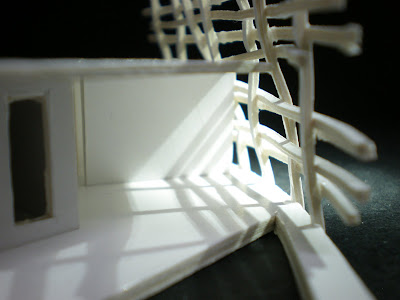





 Leah Rodighiero 100083725
Leah Rodighiero 100083725
This house was inspired first by a piece of street art and second by the interlacing nature of something woven. The house, in plan and elevation is very controlled, nothing is left to chance. This reflects the personality of the consulate official who likes to have control in all aspects of her life, she doesn’t believe in chance.
One can enter the dwelling from the north or south, which offer a different perspective to the visitor. From the south one is pushed into the very crux of the house, the parting of paths. It seems that the walls meet at odd angles but still manage to work cohesively as one travels throughout the house. Unit 7 is at the end of the main strip, as you stand at the doorway one can see the whole room simply by looking in. A small pond soothes the mind, eyes and ears, it is quiet, nothing can be heard but your own thoughts. Light and warmth stream into the room from above and rest upon you as you sit, listening, reflecting, pausing.
The interlaced element of the woven walls, contribute to the residence aesthetically and mentally. As the sun glides through the sky, the shadows cast by the weave play on the surfaces within the house. Just as a spider makes a web, the character has embedded her most precious memories, vivid and faint, past and present.




It is a collection of volumes, seven in all, each serves a purpose…because life without purpose is no life at all. The connection between the volumes is evident; the relationship however can only be explored inside the walls of the house. Spatial relationship of one unit to another unit is key to functionality and experiential qualities within the house. Connections between friends and family can be made quite easily, but relationships take time, nurturing, commitment and love.
A consulate official is a person who has structure, stability, order and organisation. Often organisation is hard to escape, everything is written down, times, dates, places, meetings, people, events… thoughts, to do’s. The house is a journal of the every day. Evidence of sleeping, waking, eating, bathing, pondering, thinking, studying, reading, relaxing, absorbing, and most importantly living.
It’s a hotchpotch of units. The organisation and order are concealed within the jumbled mixture of elements. The main entry point is the beginning of your journey. As you approach the centre of the halls there are three paths to be taken, one leads to unit 8, another to units 1, 2, 3 and 4, and the third, if the need to be cleansed is compelling, units 9,10,11,12 await. The epicentre of the house accommodates an aquarium of fish, the road less travelled leads to unit 6, and on the left, unit 5, a place to recoup.






 The woven walls incorporated into the design
The woven walls incorporated into the design  The play of light and shadows is something that
The play of light and shadows is something that 


 I was at Sydney Airport recently and saw this
I was at Sydney Airport recently and saw this I found this also at the Airport, (I spent 4
I found this also at the Airport, (I spent 4
 All these things then inspired me to incorporate a weaved form into my house design. This is
All these things then inspired me to incorporate a weaved form into my house design. This is